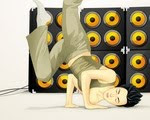
The dance is one of the three major arts of antiquity, next to the theater and music. It is characterized by the use of body movements by following previously established (choreography) or improvised (free dance). In most cases, the dance, with cadenced steps is accompanied by sound and rhythm of music and involves the expression of feelings boosted by it.
The dance can be as artistic expression or as a form of entertainment and / or ceremony. Like art, dance is expressed through the signs of movement, with or without musical link, to a certain audience, which over time was unrelated to the particular theater. Currently, the dance demonstrates in the streets at events such as "Dance in transit" in the form of video, the so-called "video dance", and in any other environment in which contextualized for the purpose of art.
Contents
1 History of dance
2 Dance & education
3 Classification and genres
The history of theatrical dance represents a change of meaning of artistic purposes over time. In Classical Ballet, the narratives and environments is illusory that guided the scene. With the social changes of modern times, began to question certain virtuosity present in the ballet and began to appear different movements of modern dance.
It is important to note that at that time, the social infer much in artistic achievement, making then the American Modern Dance to eventually become quite different from European modern dance, even with some elements in common. Contemporary dance has emerged as a new art form, both suffering influences of all past movements, and new technological possibilities (video, installation). That was also very influenced by new social conditions - increasing individualism, urbanization, and spread amounts of media, giving rise to new proposals for art, it also led to mergers with other artistic areas such as the theater for example.
Dance and Education
Rodrigo Amorim (2000) considers education as evolution and transformation of the individual, considering the dance as a continuum of physical education, expression and embodiment of considering the movement a way to view the embodiment of our students, the dance school should provide opportunities for students to develop all areas of human behavior and, through diversification and complexity, the teacher can contribute to the formation of more complex body structures. The physical educator using the dance but the biological aspect that is your area of expertise. It must be clear that physical education teacher is not a dance teacher. Although this work is to use dance as a tool in health clubs for physical fitness and improve the quality of life for example. The Physical Education courses do not form or qualify for professional dance, ballet is the artist, dancer or choreographer, teacher much less of these artistic activities. It is necessary that physical education professionals have this moral respect, because artists are not much less teachers of any artistic activities including dance. The teaching of dance in Brazilian schools must be addressed within the contents of Arts, according to the National Curriculum Parameters (www.mec.gov.br source) is required curricular component, looking for elementary school visual arts, dance, music and theater, and for the school, and these languages already mentioned, there is the inclusion of Audiovisual Arts. (PCN - BRAZIL, 2000, p.46) The approach of dance within the context of physical education is complementary and should assist in preparing for the physical arts professionals can act. Dance is an autonomous area of knowledge, even within the Arts, and must be respected and recognized as such. Training for teachers and artists of dance is gained in courses in dance (and bachelor degrees) and the profession is regulated by Law 6533/78 the Law of the Artist.
Classification and genres
Dance BharatanatyamVárias classifications of dances can be made, taking into account different criteria. On how to dance: solo dance (eg, soloist choreography in ballet, tap); dance in pairs (eg, tango, salsa, waltz, forró etc.); dance group (eg, round dances, tap). On Origin folk dance (eg catira, carimbó, Epiphany etc); historical dance (eg, sarabande, bourré, gavotte etc.); ceremonial dance (eg Indian ritual dances); ethnic dance (eg, traditional dances from countries or regions). The purpose: erotic dance (for example, can can, striptease, pole dancing); performative or theatrical dance (eg ballet, belly dancing, tap dance); social dance (eg, ballroom dancing, ax); religious dance / dance prophetic (eg, Sufi dancing).



















